radio JAGUAR S TYPE 2005 1.G Technical Guide Update
[x] Cancel search | Manufacturer: JAGUAR, Model Year: 2005, Model line: S TYPE, Model: JAGUAR S TYPE 2005 1.GPages: 133, PDF Size: 3.48 MB
Page 9 of 133
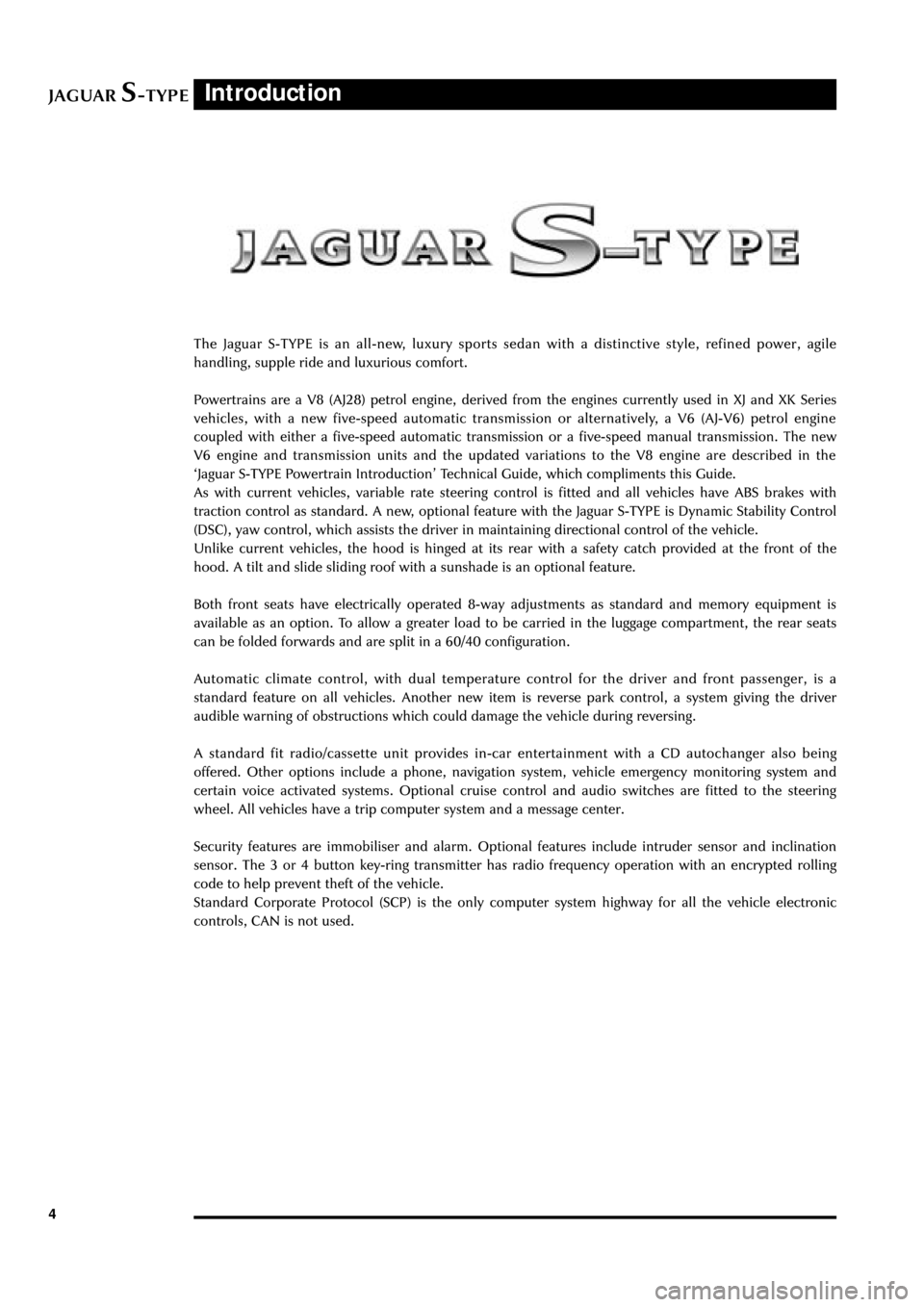
JAGUARS-TYPE
4
Introduction
The Jaguar S-TYPE is an all-new, luxury sports sedan with a distinctive style, refined power, agile
handling, supple ride and luxurious comfort.
Powertrains are a V8 (AJ28) petrol engine, derived from the engines currently used in XJ and XK Series
vehicles, with a new five-speed automatic transmission or alternatively, a V6 (AJ-V6) petrol engine
coupled with either a five-speed automatic transmission or a five-speed manual transmission. The new
V6 engine and transmission units and the updated variations to the V8 engine are described in the
ÔJaguar S-TYPE Powertrain IntroductionÕ Technical Guide, which compliments this Guide.
As with current vehicles, variable rate steering control is fitted and all vehicles have ABS brakes with
traction control as standard. A new, optional feature with the Jaguar S-TYPE is Dynamic Stability Control
(DSC), yaw control, which assists the driver in maintaining directional control of the vehicle.
Unlike current vehicles, the hood is hinged at its rear with a safety catch provided at the front of the
hood. A tilt and slide sliding roof with a sunshade is an optional feature.
Both front seats have electrically operated 8-way adjustments as standard and memory equipment is
available as an option. To allow a greater load to be carried in the luggage compartment, the rear seats
can be folded forwards and are split in a 60/40 configuration.
Automatic climate control, with dual temperature control for the driver and front passenger, is a
standard feature on all vehicles. Another new item is reverse park control, a system giving the driver
audible warning of obstructions which could damage the vehicle during reversing.
A standard fit radio/cassette unit provides in-car entertainment with a CD autochanger also being
offered. Other options include a phone, navigation system, vehicle emergency monitoring system and
certain voice activated systems. Optional cruise control and audio switches are fitted to the steering
wheel. All vehicles have a trip computer system and a message center.
Security features are immobiliser and alarm. Optional features include intruder sensor and inclination
sensor. The 3 or 4 button key-ring transmitter has radio frequency operation with an encrypted rolling
code to help prevent theft of the vehicle.
Standard Corporate Protocol (SCP) is the only computer system highway for all the vehicle electronic
controls, CAN is not used.
Page 25 of 133

JAGUARS-TYPEBody
20system mirrors. A clear patch in the darkened
area at the bottom left of the windshield gives
external visible access to the VIN.
There are three types of windshield variants:
¥ Rain sensing, with electrochromic mirror
(NAS markets have the option of a compass
fitted to the mirror head).
¥ Non-rain sensing with electrochromic mirror
(NAS markets have the option of a compass
fitted to the mirror head).
¥ Non-rain sensing with prismatic mirror.
Windshields are available as heated or non-
heated and the rain sensing versions have a
unique mirror mounting system.
Backlight
The backlight is direct glazed to body. All
backlights are heated and have solar control tint,
integral radio and telephone antenna. The
backlight heater is timed on for 10 minutes.
Door glass
Each front door window is single curvature glass,
5mm thick, and operated by a twin guide cable
and drum assembly with five stud fixing points.
The glass is clamped to the regulator slide blocks.
Access holes are provided in the inner door when
the glass is raised. There are no adjustable end of
travel stops.
Rear door glass is also a single curvature glass,
4mm thick, with a single guide cable and drum
assembly and three stud fixing points. The glass
drops fully to the door roll. The glass is located to
the slider blocks by pins and has no adjustable
end of travel stops.
Each front and rear cable and drum mechanisms
must be replaced as individual complete units,
they have no serviceable parts.
Quarter lights
Quarter lights are 4mm thick with three fixings,
one is a lower bracket to the door inner.
Perimeter foam and butyl rubber seals are fitted
to the door outer.
Page 86 of 133

JAGUARS-TYPEElectrical/Electronic
81 No Type Rating (amps) Colour Circuit
10 - - - Not used
11 mini 15 Blue HO2 sensor (catalyst)
12 mini 10 Red Coil on plug
13 cartridge 40 or 30 Green or Pink RH heated windshield or heated wiper
park (where fitted)
14 - - - Not used
15 cartridge 40 Green LH heated windshield
16 cartridge 30 Pink Blower motor
17 - - - Not used
18 cartridge 40 Green Powertrain control module (PCM)
19 - - - Not used
20 - - - Not used
21 cartridge 30 Pink Starter solenoid
22 cartridge 30 Pink ABS motor
23 cartridge 20 Blue Wiper motor
24 cartridge 30 Pink Head lamp washer pump
25 cartridge 80 - Cooling fan motor
Diode 1 PCM
Passenger Compartment Fusebox
No Type Rating (amps) Colour Circuit
1 mini 5 Brown Starter relay coil via Park/Neutral switch
2 mini 5 Brown Radio
3 mini 5 Brown ABS/DSC module
4 mini 5 Brown PCM relay coil, instrument pack, RECM,
fuel pump relay, transit relay
5 mini 5 Brown Autolamp sensor, heated seat module
switch & overdrive cancel switch RSM, BSI
6 mini 10 Red OBDII
7 mini 5 Brown DDCM, DSCM, PCM, Anti-theft LED,
security horn, power mirror
8 mini 5 Brown Right-front direction indicators, side
repeaters, side markers, park lights
9 mini 10 Red Right-front low beam headlamp
10 mini 5 Brown Left-front direction indicators side
repeaters, side markers, park lamps
11 mini 10 Red Left-front main beam lamp
12 mini 10 Red Headlamp levelling, ABS/DSC module
13 mini 5 Brown Instrument pack
14 mini 10 Red RCM, Dual Automatic Temperature
Control (DATC) module
Page 87 of 133

JAGUARS-TYPEElectrical/Electronic
82No Type Rating (amps) Colour Circuit
15 mini 5 Brown Adaptive damping module (ADRC)
16 mini 5 Brown Heated seat switch module,
electrochromic mirror, rain sensor
17 mini 5 Brown RCM, Generator warning lamp
18 mini 20 Yellow Radio, cellular phone, navigation unit
19 mini 15 Blue Steering column motors
20 mini 10 Red GECM, DATC, RECM, Instrument Pack,
brake shift interlock
21 mini 10 Red Power folding mirrors, electric sunblind
22 mini 10 Red DriverÕs door mirror, driverÕs door lock
motor
23 mini 10 Red Right-front high beam
24 mini 5 Brown Passive Anti-Theft System (PATS)
25 mini 10 Red Left-front low beam headlamp
26 - - - Not used
27 mini 10 Red Navigation display, radio, phone,
navigation module, Traffic Master
28 mini 5 Brown Battery-backed security sounder
29 mini 5 Brown Voice control, reversing aid, GECM,
Trailer tow ignition sense, VEMS
30 mini 5 Brown GECM
31 - - - Not used
32 mini 20 Yellow Accessory socket, cigar lighter
33 mini 10 Red GECM illumination power
34 - - - Not used
35 mini 5 Brown Stop lamp switch
Trunk Fusebox
No Type Rating (amps) Colour Circuit
1 mini 15 Blue Luggage compartment release solenoid
2 mini 10 Red Right rear direction indicators, back up,
fog lamps, side markers
3 mini 10 Red Left stop lamp
4 mini 10 Red Fuel door release solenoid
5 mini 10 Red Courtesy and map lamps
6 mini 10 Red Left rear direction indicators, back up,
fog lamps, side markers
7 mini 10 Red Right stop lamp
8 mini 10 Red Center high mounted stop lamp
9 mini 5 Brown Heated mirror
10 mini 5 Brown Traffic Master
11 mini 15 Blue Heated seats
Page 103 of 133
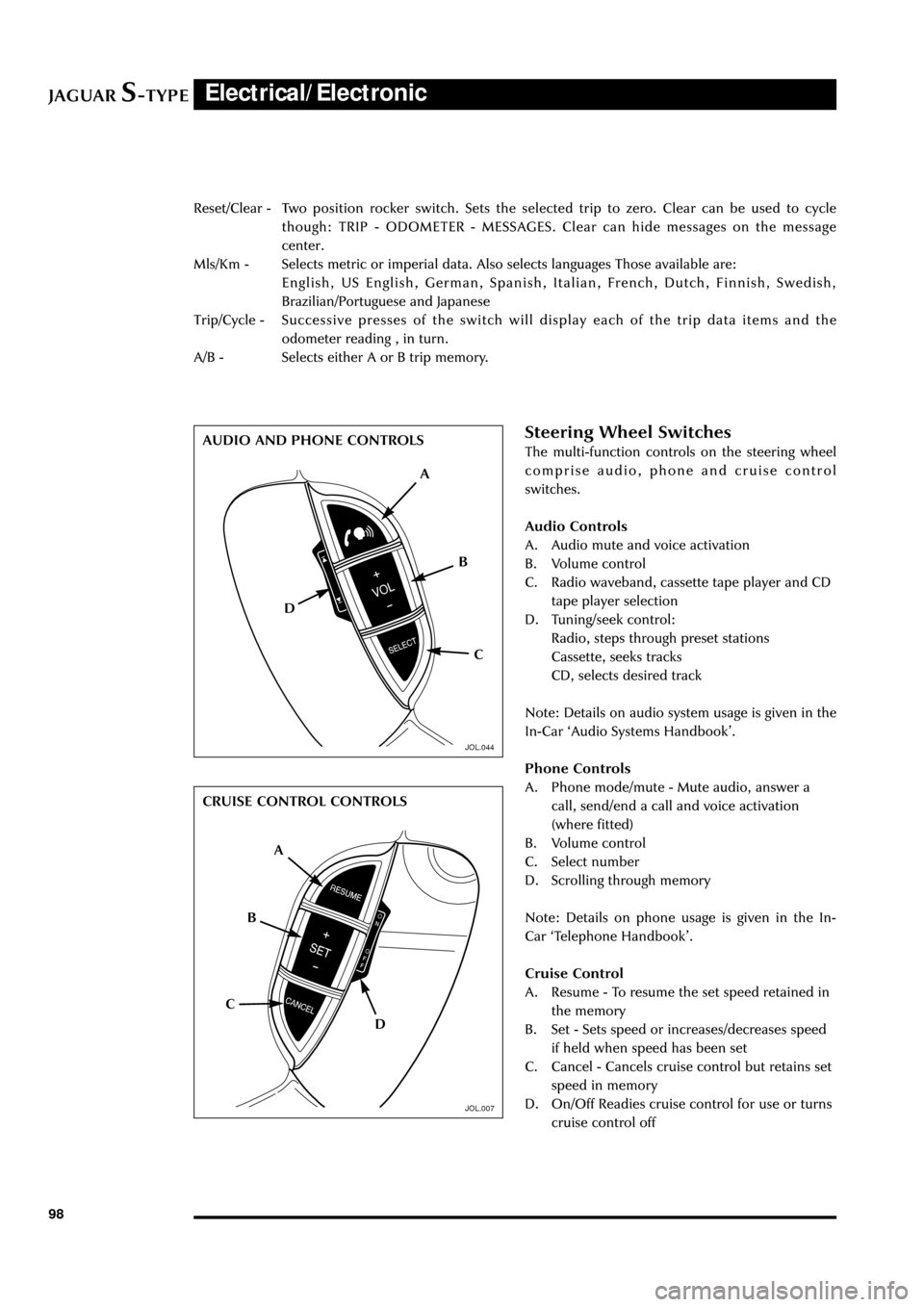
JAGUARS-TYPEElectrical/Electronic
98Reset/Clear - Two position rocker switch. Sets the selected trip to zero. Clear can be used to cycle
though: TRIP - ODOMETER - MESSAGES. Clear can hide messages on the message
center.
Mls/Km - Selects metric or imperial data. Also selects languages Those available are:
English, US English, German, Spanish, Italian, French, Dutch, Finnish, Swedish,
Brazilian/Portuguese and Japanese
Trip/Cycle - Successive presses of the switch will display each of the trip data items and the
odometer reading , in turn.
A/B - Selects either A or B trip memory.
Steering Wheel Switches
The multi-function controls on the steering wheel
comprise audio, phone and cruise control
switches.
Audio Controls
A. Audio mute and voice activation
B. Volume control
C. Radio waveband, cassette tape player and CD
tape player selection
D. Tuning/seek control:
Radio, steps through preset stations
Cassette, seeks tracks
CD, selects desired track
Note: Details on audio system usage is given in the
In-Car ÔAudio Systems HandbookÕ.
Phone Controls
A. Phone mode/mute - Mute audio, answer a
call, send/end a call and voice activation
(where fitted)
B. Volume control
C. Select number
D. Scrolling through memory
Note: Details on phone usage is given in the In-
Car ÔTelephone HandbookÕ.
Cruise Control
A. Resume - To resume the set speed retained in
the memory
B. Set - Sets speed or increases/decreases speed
if held when speed has been set
C. Cancel - Cancels cruise control but retains set
speed in memory
D. On/Off Readies cruise control for use or turns
cruise control off
A
D
C B AUDIO AND PHONE CONTROLS
CRUISE CONTROL CONTROLS
A
D CB
JOL.044
JOL.007
Page 111 of 133
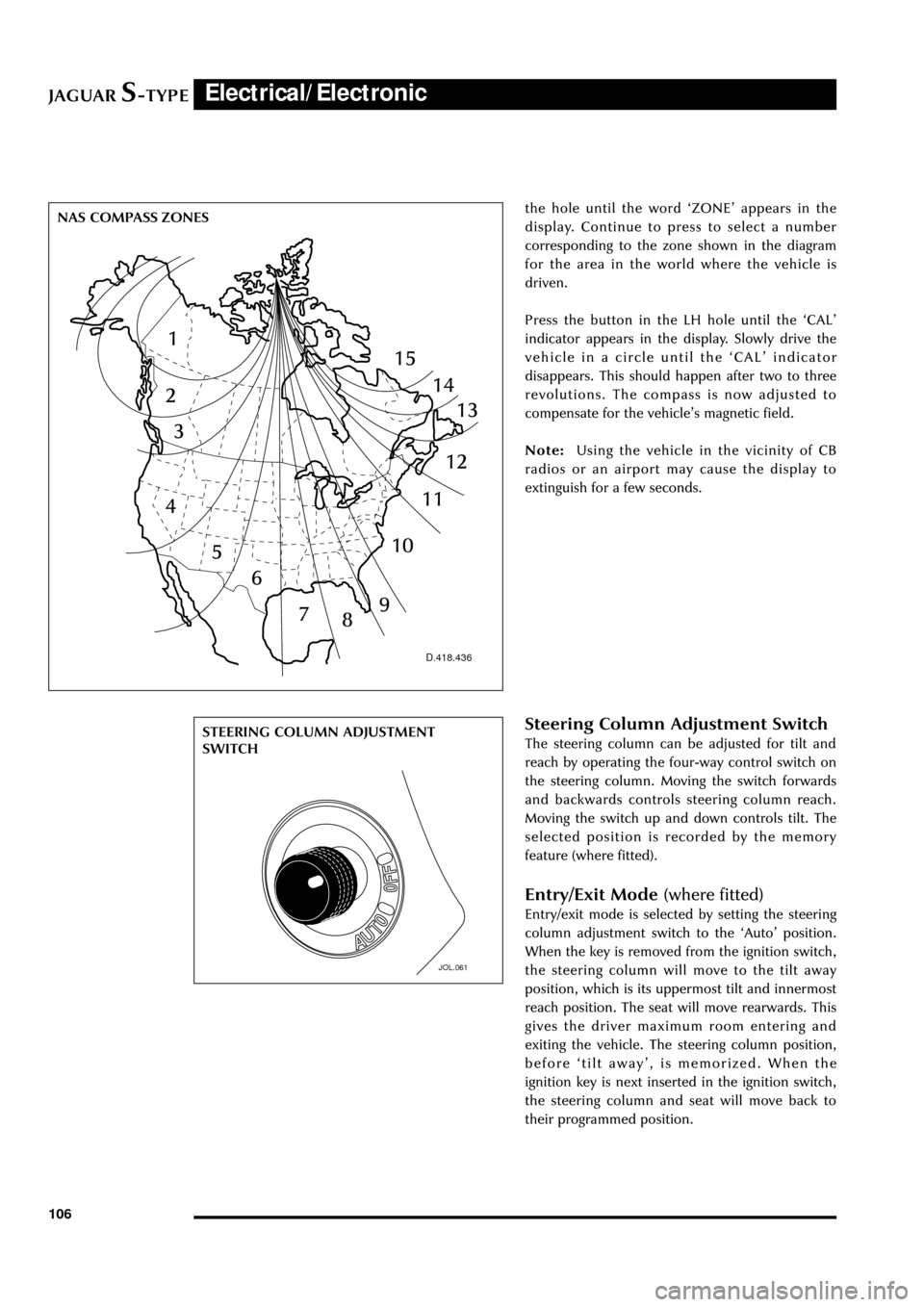
JAGUARS-TYPEElectrical/Electronic
106the hole until the word ÔZONEÕ appears in the
display. Continue to press to select a number
corresponding to the zone shown in the diagram
for the area in the world where the vehicle is
driven.
Press the button in the LH hole until the ÔCALÕ
indicator appears in the display. Slowly drive the
vehicle in a circle until the ÔCALÕ indicator
disappears. This should happen after two to three
revolutions. The compass is now adjusted to
compensate for the vehicleÕs magnetic field.
Note:Using the vehicle in the vicinity of CB
radios or an airport may cause the display to
extinguish for a few seconds.
D.418.436
JOL.061
STEERING COLUMN ADJUSTMENT
SWITCH NAS COMPASS ZONESSteering Column Adjustment Switch
The steering column can be adjusted for tilt and
reach by operating the four-way control switch on
the steering column. Moving the switch forwards
and backwards controls steering column reach.
Moving the switch up and down controls tilt. The
selected position is recorded by the memory
feature (where fitted).
Entry/Exit Mode (where fitted)
Entry/exit mode is selected by setting the steering
column adjustment switch to the ÔAutoÕ position.
When the key is removed from the ignition switch,
the steering column will move to the tilt away
position, which is its uppermost tilt and innermost
reach position. The seat will move rearwards. This
gives the driver maximum room entering and
exiting the vehicle. The steering column position,
before Ôtilt awayÕ, is memorized. When the
ignition key is next inserted in the ignition switch,
the steering column and seat will move back to
their programmed position.
Page 112 of 133
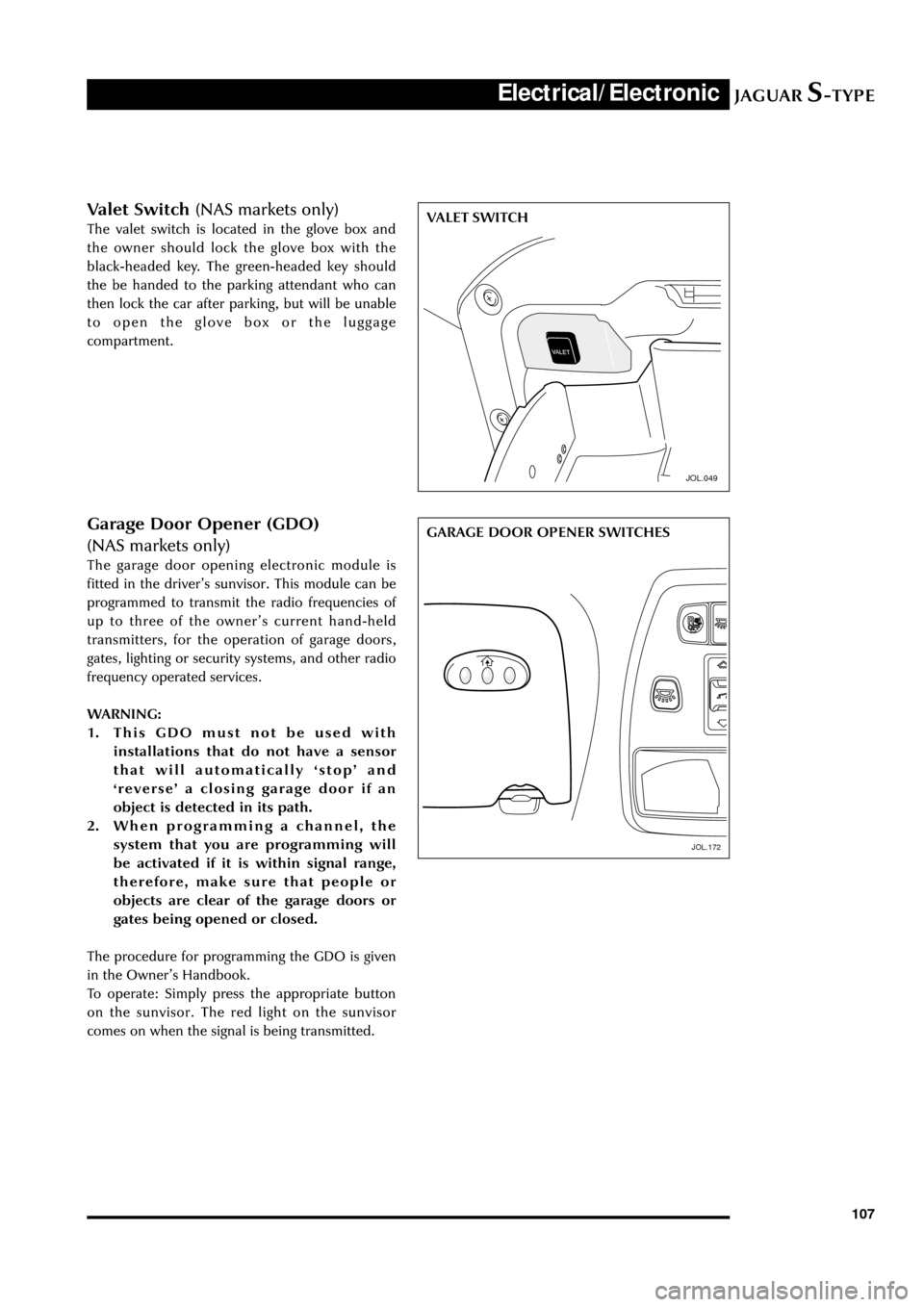
JAGUARS-TYPEElectrical/Electronic
107
Valet Switch (NAS markets only)
The valet switch is located in the glove box and
the owner should lock the glove box with the
black-headed key. The green-headed key should
the be handed to the parking attendant who can
then lock the car after parking, but will be unable
to open the glove box or the luggage
compartment.
JOL.049
VALET SWITCH
JOL.172
GARAGE DOOR OPENER SWITCHESGarage Door Opener (GDO)
(NAS markets only)
The garage door opening electronic module is
fitted in the driverÕs sunvisor. This module can be
programmed to transmit the radio frequencies of
up to three of the ownerÕs current hand-held
transmitters, for the operation of garage doors,
gates, lighting or security systems, and other radio
frequency operated services.
WARNING:
1. This GDO must not be used with
installations that do not have a sensor
that will automatically ÔstopÕ and
ÔreverseÕ a closing garage door if an
object is detected in its path.
2. When programming a channel, the
system that you are programming will
be activated if it is within signal range,
therefore, make sure that people or
objects are clear of the garage doors or
gates being opened or closed.
The procedure for programming the GDO is given
in the OwnerÕs Handbook.
To operate: Simply press the appropriate button
on the sunvisor. The red light on the sunvisor
comes on when the signal is being transmitted.
JOL.172
Page 113 of 133

JAGUARS-TYPEElectrical/Electronic
108
Security and Locking Systems
Introduction
The following security and locking features are
available but vary by market or options:
¥ Key barrel on driverÕs side only
¥ Encrypted engine immobilization by ignition
key transponder
¥ Radio frequency remote fob
¥ Central locking by key and remote fob
¥ Double locking (not in North America, Japan,
Taiwan)
¥ Drive away door locking
¥ Mechanical child locks on rear doors
¥ Perimeter alarm of doors, bonnet, trunk
¥ Intrusion sensing, ultrasonically sensed (not
in North America, Japan, Taiwan)
¥ Inclination (tilt) sensing (Dealer fit accessory)
¥ Panic alarm, fob operated (certain markets)
¥ Trunk lock isolate (valet lockout, see page
107) - North America only
¥ Electro/mechanical steering column lock
The following convenience features are included
either as standard or optional features:
¥ Remote fob operated driverÕs seat, door
mirrors and steering column memory recall
(two memories)
¥ Remote fob operated trunk lid release
¥ Key operated global close (sliding roof and all
windows)
¥ Key and fob remote-operated global open
(sliding roof and all windows)
¥ Trunk lid and fuel flap interior release buttons
¥ Trunk release button in trunk plinth
¥ Emergency key lock barrel under trunk plinth.
System Description
The security system is controlled by a driver door
control module (DDCM). When activated
unauthorized entry in to the vehicle is detected by
the courtesy lamp switches. When the alarm is
triggered, the system flashes the turn signal lamps
and sounds the alarm system horns.
The passive anti-theft system (PATS) is a feature to
prevent the vehicle being driven away by an
unauthorized person. The PATS system consists of
electronically coded keys, a transceiver and is
controlled by the Instrument Pack. When the
ignition is switched to position ÔIIÕ, the transceiver
energises the ignition key to read its electroniccode that is transmitted back. If the read code
equals a stored code in the control module, the
steering column is unlocked and the powertrain
control module (PCM) will let the engine start.
Otherwise, starting of the engine is disabled
(through the starter disable relay and the PCM).
The security indicator LED provides the driver
with the status of the PATS or security system. If
the security system is armed the light will flash
when the ignition is switched OFF. The PATS light
will illuminate when the key is inserted into the
ignition lock and turned to position ÔIIÕ. It will stay
illuminated until the system has carried out its test
on the key. If the system detects a fault, it will
flash the LED for 1 minute, and then flash out the
corresponding 2 digit fault code.
Security System Operating Components
Key to illustration on the following page:
1. Four button transmitter (North America/Rest
of the World)
2. Three button transmitter (Europe/Japan)
3. Trunk release switch
4. Trunk compartment actuator
5. Intrusion sensor
6. Door actuator
7. Driver door control module
8. Data link connector
9. General electronic control module
10. PATS transceiver module
11. Hood switch
12. Security LED
13. Horns
14. Security horn
15. Security sounder
16. Intrusion sensor
17. Rear electronic control module
Page 115 of 133
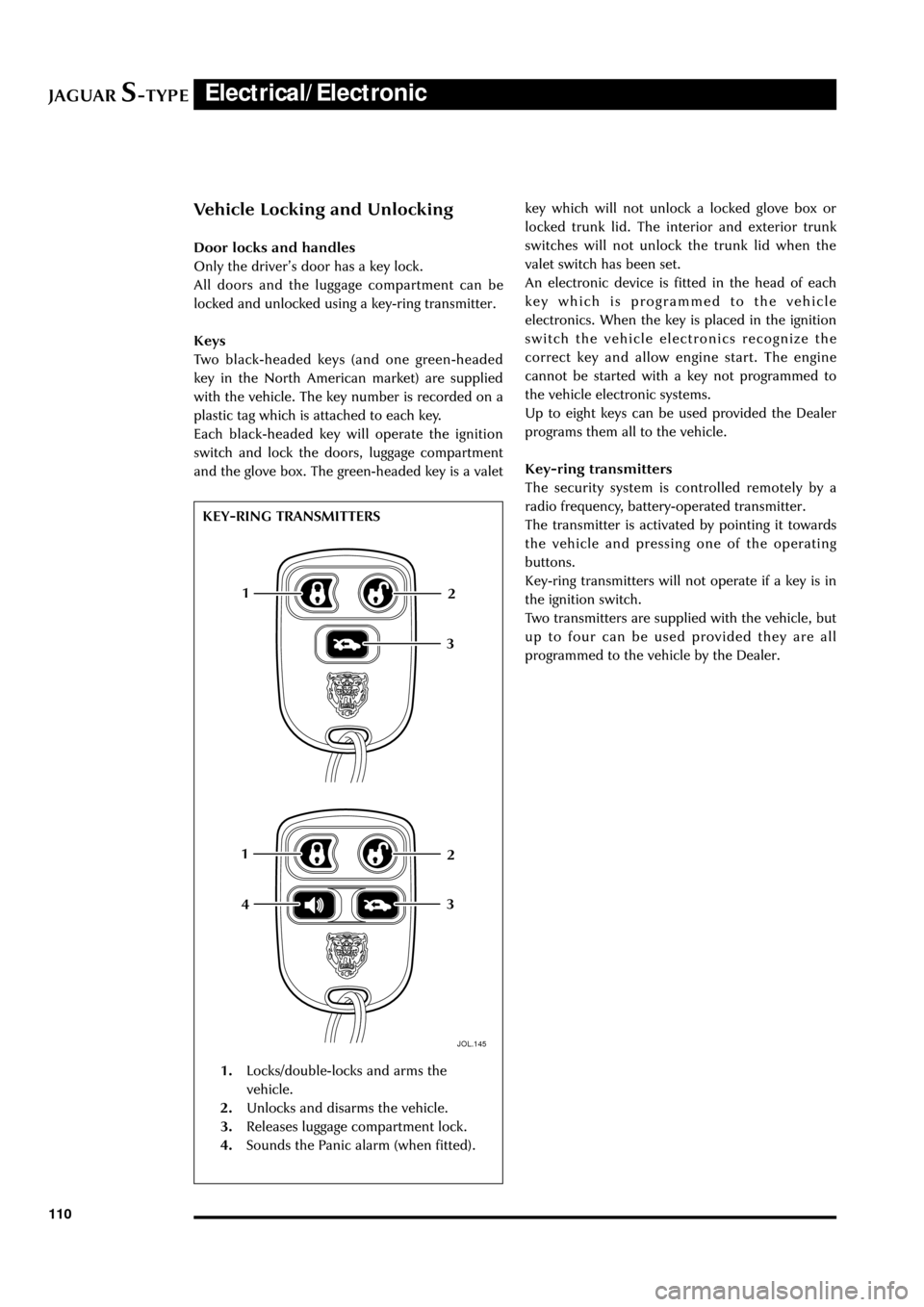
JAGUARS-TYPEElectrical/Electronic
110
JOL.145
Vehicle Locking and Unlocking
Door locks and handles
Only the driverÕs door has a key lock.
All doors and the luggage compartment can be
locked and unlocked using a key-ring transmitter.
Keys
Two black-headed keys (and one green-headed
key in the North American market) are supplied
with the vehicle. The key number is recorded on a
plastic tag which is attached to each key.
Each black-headed key will operate the ignition
switch and lock the doors, luggage compartment
and the glove box. The green-headed key is a valetkey which will not unlock a locked glove box or
locked trunk lid. The interior and exterior trunk
switches will not unlock the trunk lid when the
valet switch has been set.
An electronic device is fitted in the head of each
key which is programmed to the vehicle
electronics. When the key is placed in the ignition
switch the vehicle electronics recognize the
correct key and allow engine start. The engine
cannot be started with a key not programmed to
the vehicle electronic systems.
Up to eight keys can be used provided the Dealer
programs them all to the vehicle.
Key-ring transmitters
The security system is controlled remotely by a
radio frequency, battery-operated transmitter.
The transmitter is activated by pointing it towards
the vehicle and pressing one of the operating
buttons.
Key-ring transmitters will not operate if a key is in
the ignition switch.
Two transmitters are supplied with the vehicle, but
up to four can be used provided they are all
programmed to the vehicle by the Dealer.
1
12
2
3
3
4
1.Locks/double-locks and arms the
vehicle.
2.Unlocks and disarms the vehicle.
3.Releases luggage compartment lock.
4.Sounds the Panic alarm (when fitted). KEY-RING TRANSMITTERS
Page 121 of 133
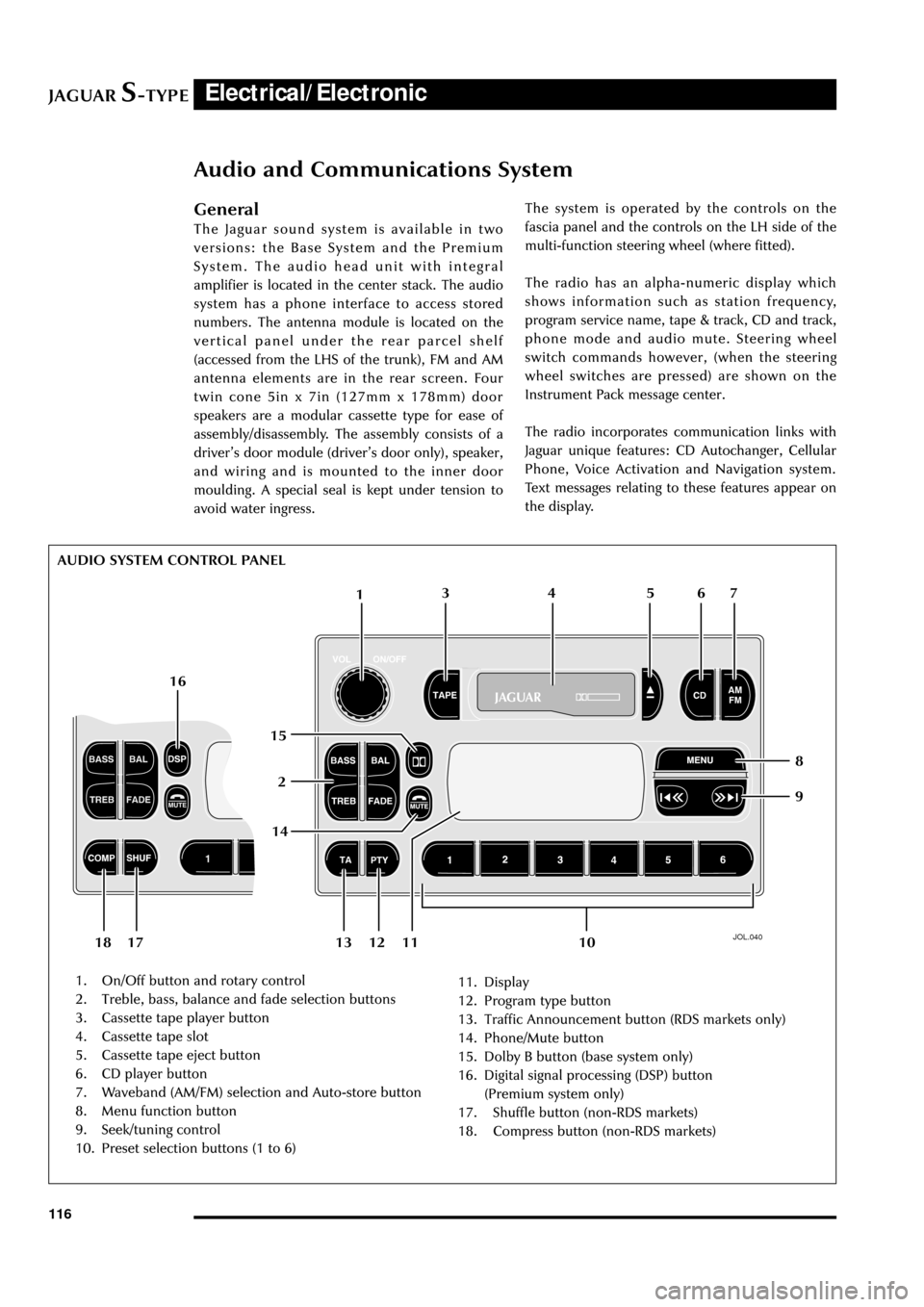
JAGUARS-TYPEElectrical/Electronic
116
Audio and Communications System
General
The Jaguar sound system is available in two
versions: the Base System and the Premium
System. The audio head unit with integral
amplifier is located in the center stack. The audio
system has a phone interface to access stored
numbers. The antenna module is located on the
vertical panel under the rear parcel shelf
(accessed from the LHS of the trunk), FM and AM
antenna elements are in the rear screen. Four
twin cone 5in x 7in (127mm x 178mm) door
speakers are a modular cassette type for ease of
assembly/disassembly. The assembly consists of a
driverÕs door module (driverÕs door only), speaker,
and wiring and is mounted to the inner door
moulding. A special seal is kept under tension to
avoid water ingress.
JOL.040
1. On/Off button and rotary control
2. Treble, bass, balance and fade selection buttons
3. Cassette tape player button
4. Cassette tape slot
5. Cassette tape eject button
6. CD player button
7. Waveband (AM/FM) selection and Auto-store button
8. Menu function button
9. Seek/tuning control
10. Preset selection buttons (1 to 6)11. Display
12. Program type button
13. Traffic Announcement button (RDS markets only)
14. Phone/Mute button
15. Dolby B button (base system only)
16. Digital signal processing (DSP) button
(Premium system only)
17. Shuffle button (non-RDS markets)
18. Compress button (non-RDS markets)The system is operated by the controls on the
fascia panel and the controls on the LH side of the
multi-function steering wheel (where fitted).
The radio has an alpha-numeric display which
shows information such as station frequency,
program service name, tape & track, CD and track,
phone mode and audio mute. Steering wheel
switch commands however, (when the steering
wheel switches are pressed) are shown on the
Instrument Pack message center.
The radio incorporates communication links with
Jaguar unique features: CD Autochanger, Cellular
Phone, Voice Activation and Navigation system.
Text messages relating to these features appear on
the display.
1
26 5 4 3
109 8 7
11 13 12 1814 16
15
17 AUDIO SYSTEM CONTROL PANEL